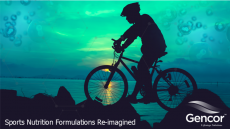The trends shaping the sports beverages market

Nandini Roy Choudhury, client partner for Food and Beverage at Future Market Insights (FMI), joined the Vitafoods Insights Europe Virtual Expo to provide the top line consumer insights for brands looking to succeed in the functional drinks category and the top trends impacting this sector in the coming years.
She began by revealing that sports and energy drinks are the top category of functional product in the world.
She revealed the global sports nutrition market is a 30bn USD opportunity, expected to grow to 64bn USD in the next decade and growing at nearly 30% in Europe alone.
A sizeable 80% of global consumers have tried sports drinks and 77% have tried energy drinks - much higher figures than seen across other categories such as snack bars (46%), RTD protein drinks (32%) and sports gels (16%).
Choudhury explains that drinks are excellent, flexible and convenient vehicles for functional ingredients with a wide consumer demographic, from children through to older adults.
The category is evolving to encompass more women too which will FMI says will lead to the evolution of a completely new portfolio of products and ingredients targeted at women’s health.
“However creating completely new or reformulating drinks is not simple," Choudhury adds, "there are significant technical, regulatory and nutritional boarders which the industry needs to cater to.”
Key drivers
When looking at the consumer trends driving this category, Choudhury says the key drivers are functionality, better for you (mind and body), naturalness (fewer ingredients), and sustainability.
The most common and prominent trend is the ‘natural’ trend, with 69% of consumers consuming sports nutrition products agreeing that the products contain too many artificial ingredients.
When consumers surveyed by FMI referred to ‘natural’ products, 44% cited chemicals as being the most important food safety issue and 39% cited artificial flavours. In line with this, 32% of launches in the last three years included a ‘natural’ claim.
Looking at what ingredients consumers do want to see in these products, FMI found the top ingredients sought in fortified sports drinks are: real fruit (54%), vitamin D (51%), added calcium (42%), and added fibre (30%).
Cognitive health in focus
The insights also reveal the consumer mindset transition from purely physical health benefits, to mental health too.
When asked what sort of health benefits they want from their drinks, immune function support came out on top (59%), closely followed by ‘clean energy’ (58%), cognitive health (54%), digestive and metabolic health (51%), sports/recovery (50%), eye health (49%), relaxation and mood support (43%).
And looking at the functional dairy category, the main health concerns that consumers are trying to target are slightly different: cognitive health (43%), digestive health (62%), and a substantial 78% of consumers want products to help them to ‘sleep better’.
Choudhury notes that selecting the right ingredient and combination of ingredients will be key to commanding consumer confidence.
The trending ingredients that FMI has identified are: acerola powder, green tea, black tea, yerba mate, guarana, acai, beetroot, hibiscus, chamomile, fibers, pre-, pro-, and postbiotics.
Speaking about the typical types of ingredients accepted as having a cognitive health benefit, Choudhury points out that omega-3&6 (88%) and botanicals (83%) are the most accepted additions. These are followed by gingko biloba (72%), caffeine (71%), iodine (69%), MCT oil (52%), nootropics (51%), and resveratrol (43%).
Summing up, Choudhury says innovation is the key to success in this area, adding that "introducing new blends, hybrids, and fortified drinks is something that the customer base wants."
And, of course, a common trend across the functional food & beverage domain is personalised nutrition, wherein producers are striving to customise products as per the nutritional requirements of the consumer.
"Personalisation will be the next big thing," Choudury concludes, "the brand must focus on what sort of consumer demographic they are targeting and what sort of income group they are targeting. This will be important to have a personalised product rather than a general product focusing on the mass."














